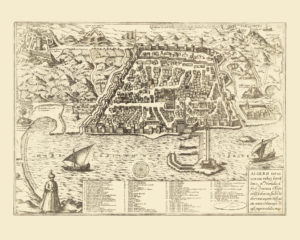Map of the City of Algiers, 1575.
Algiers was an important hub in 16th century North Africa. The part of the Ottoman Empire covering what is today Algeria, Tunisia and Libya was governed from Algiers. Piracy and raiding were popular activities of the Algerian rulers at this time and they organised numerous slave-hunting expeditions to the Western Mediterranean. Large populations were affected, namely on the islands of Gozo, Lipari, and Corsica. Several decades later, the coastal regions of Spain and Portugal also became a target of the Barbary pirates’ raids. These slave-hunting expeditions eventually reached as far as Iceland in 1627. The famous Spanish writer Miguel de Cervantes spent five years as a slave in Algiers. He was captured together with the rest of the galley crew while in their way from Naples to Barcelona.
“The Barbary Pirates 15th–17th centuries” by pirate expert Angus Kunstam and illustrated by Gerry Embleton is a great introduction to the era of piracy in the 17th century Mediterranean.
Buy restored reproduction of this map printed on a high quality handmade paper here.






















